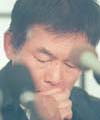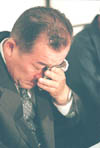By Glenn Scott
and Scott Ishikawa
Advertiser Staff Writers
The ship captain and the school principal, two men of contrasting style, sat shoulder to shoulder last night at a small table in a hopelessly crowded room. They were different by nature but united by harsh circumstance.
 |
| Ehime Maru Capt. Hisao Onishi weeps as he describes how he tried to find the missing boaters from his ship.
Eugene Tanner • The Honolulu Advertiser |
The occasion was a press conference at the Japanese Cultural Center in Honolulu. With more international journalists arriving by the hour, especially from Japan, this was the moment when both men were to connect with the audience back home and explain how innocent people had coped with a maritime collision and tragedy.
But to do that, the two leaders had to endure the hard white lights of video cameras and the glassy stares of lenses that seemed to follow the rise and fall of their words. Shutters fired at every short pause, every protective hand to the face.
Ehime Maru Captain Hisao Onishi, 58, spoke in slow, flat passages, a sign of his discomfort and continuing shock. He never looked up, never acknowledged the faces and the camera lenses, as he told of his training ship submerging soon after it was rocked by a reverberating boom from below.
The captain wore a dark blue jacket over a white T-shirt. His hair was pushed forward toward his brow. He spoke slowly, paused often. His stare fell only on the white tablecloth covering a table cluttered with a dozen microphones and even more portable tape recorders.
The principal was different. Ietaka Horita wore a dark suit and sharp blue tie. His hair was brushed back, and his voice carried the relentless cadences of a motivator. This was a man accomplished at public speaking. He leaned into the lights, raising his gleaming eyes to meet the inquisitive looks of 100 or so journalists.
Onishi told his story first. It was the longer story, filled with the poignant facts of the sinking and rescue. In Japanese, he said the vessel had been traveling at 11 knots, and the ship’s engine was running at the time of the collision.
At 1:30 p.m., while Onishi and two mates were on the ship’s bridge and most of the crew and students in the mess hall, the ship was jarred twice. At first, it felt like they had hit an obstruction, but someone saw the submarine beneath the left rear of the ship, near the engine room.
As the ship began sinking, Onishi said he tried to call for help on the radio, but found it disconnected, most likely from loss of power. There was a designated place aboard the ship where everyone was supposed to meet during an emergency. He thought almost everyone was there.
He said the ship sank so quickly - within five to 10 minutes - they had no time to take out the life rafts. The boat at first sank evenly, but its front end soon began tilting in the air.
Eventually they were thrown overboard by what he describes as "a giant wave." Fortunately, the life rafts eventually floated to the surface from the sunken craft. None of the survivors wore life vests.
Onishi said those in the water tried to connect all the rafts, but some floated away in choppy seas. They managed to tie three rafts together and loaded survivors aboard. By the time Onishi climbed aboard, his watch read 1:45 p.m.
Onishi said he saw some people on the conning tower of the Greeneville, but said no one from the submarine assisted them. But he believes the submarine crew was watching over the rafts until the Coast Guard arrived.
 |
| Ietaka Horita, principal of Uwajima Fisheries High School, wiped away tears during a press conference yesterday at the Japanese Cultural Center.
Eugene Tanner • The Honolulu Advertiser |
Onishi told reporters he believes two of the missing - chief engineer Toshimichi Furuya and first engineer Hiroshi Nishida - were in the engine room during the collision. Another crewman working in the ship’s observation room outside the engine room was pushed to the upper decks by the surging water. He later told Onishi he had seen major damage beneath the engine room.
"All of a sudden, oil and vapor just blew up in the engine room," Onishi said.
As for the students, Onishi said the ones who were saved were in the same room: the mess hall. The other students who are missing were elsewhere on the ship.
As Onishi neared the conclusion of his recollection, his face grew ruddier, his voice thinner. He told how, for the first time, he realized not everyone had reached the rafts. And now, a hard day later, he missed them. He rolled his hand into a soft fist and pushed it against his mouth. The cameras’ motor drives spit. Strobes lit the ceiling like fireworks. He couldn’t hold it in, couldn’t talk.
He just looked down.
"I hoped others were still on the ocean," said Onishi, weeping. "We looked for people hard, but I couldn’t rescue anyone."
Horita, the principal, said he had come to Honolulu after the sinking to take care of thesurviving boys from Uwajima Fisheries High School. They were healthy, genki, but shaken. He wanted to give them strength.
As he met each boy, he told the reporters, he began with a big, reassuring hug.
"Yo ganbatta," he urged them in his Shikoku dialect. That meant put up a good fight. Persevere. You can do it.
But in that crowded room where too many notetakers strained to record every word, even the principal’s commanding tone began to waver. His breath turned short, giving in to the last two terrible days of travel and despair.
When he had hugged his boys, he explained, they felt cold. He imagined they were still wet and suffering. That tore him up.
In front of all those cameras, Horita couldn’t hold it back, either. The steady clicking of the camera shutters sounded like a loud rain as he, too, paused until the remorse and the bone-deep disappointment subsided yet again.
Advertiser contributor Toshi Erikson contributed to this report.
[back to top] |


